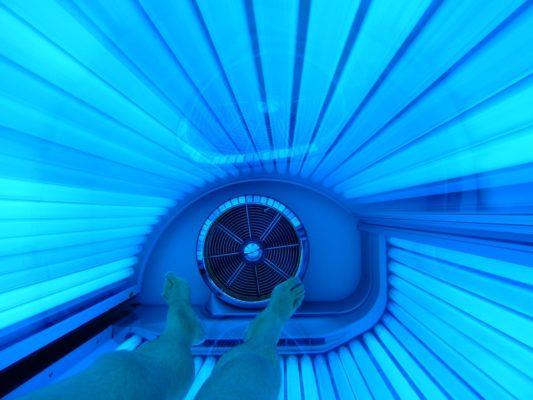You enter the world of tanning with the dream of having that exotic bronze skin. As a beginner, the chances of you being caught in the dilemma of choosing the apt method is not odd.
You might have already brainstormed a lot about natural way, sprays, and indoor tanning bed options.
Considering our daily busy schedule, changing seasons and the urge for quick results, indoor tanning is indeed the popular choice, isn’t it? I’m damn sure that you won’t argue in this. But you might argue on the best option among various indoor tanning techniques.
What I’m planning to do now is to ease you up with a proper differentiation between the stand-up and lay-down tanning bed varieties. Let’s have a stand-up tanning bed vs lay down tanning bed battle (yeah!!) Let me tell you that the comparison which I have to offer is no stereotype.
With bronzer: Dark tanning lotion (Amazon)
Without bronzer: Ed Hardy Coconut Kisses lotion (Amazon)

Table of Contents
First, the Similarities
See, although there are few key differences between these two tanning beds, they do share few basic similarities.
It’s a good idea to have a look at the similarities of stand up tanning bed and lay down tanning bed.
I have listed the similarities below:
a. Purpose: Let it be a standing tanning booth or a lay-down tanning bed, the one and only purpose of both is to gain that sun-kissed shiny skin. Both are the most rated indoor tanning methods.
b. Technology: Even though there are differences in the intensity produced, both use bulbs that emit UVA and UVB rays that results in the layer of tan in your skin.
c. The number of sessions: Both need more than one session for the base tan to develop. Of course, in just a single tanning session, I bet you won’t be satisfied.
d. The gap between sessions: Whatever the physical orientation of the tanning equipment, it is highly recommended to schedule two sessions 24 hours apart.
Differences between a stand-up Tanning Bed and Lay-down Tanning Bed
Well, this is what you were looking for.
It is the differences between the beds which make you decide among the options. Once you are clear with what to expect from these two types of beds, your choice will naturally favor your need.
Let me list out the major parameters for easy comprehension and better understanding.
1. Even coverage
We all aim for even tan results.
None will be happy to end up with some white shade under your arms or some patchy spots left out.
Since you are lying down in the lay-down tanning bed, you will definitely develop pressure points.
Those areas on your shoulders and buttock will not be tanned as evenly compared to the rest of your body because of your posture.
On the other hand, as you are standing with your arms held high, stand-up tanning bed will provide even tan coverage. There is no pressure point issue or left out spot.
2. Intensity
Some of the readers of our best tanning bulbs article were asking why we were reviewing mainly 100-120 Watts bulbs.
The reason is simple. Lay down tanning bed are the most used ones in the market and they use bulbs of this power.
Stand up tanning bed uses bulbs of 160 watts compared to the bulbs with 100-120 watts used in lay-down tanning bed variant.
The combination of stronger bulbs with unique reflector, stand-up bed tans quickly.
Usage of high intense tanning bulbs have it’s own advantages and disadvantages. We have discussed it later in the article.
3. Time Requirements
You can now simply guess that due to strong waves emitted the tanning session will be short in the stand-up bed. Yes, it is.
While the lay-down bed requires an average of 20 minutes per session, stand-up bed only asks for 10 minutes to bless you with the bronze glow you longed for.
You might think the 10 minutes of
If you’re a serious tanner, just think the advantage you’re gaining for about 2-3 tanning session per week for the next five years.
Did you see it?
4. Facial Tanning
Technically speaking, our skin becomes more resistant to UV rays as the exposure increases.
Our face is more exposed to the sun than the rest of our body and thus requires strong lamps to make face and body the same color, especially during winter.
Lay-down tanning bed have facial tanning units which can be turned on and off according to the preference of the tanner.
But this facility is not available in a vertical tanning booth which uniformly emits rays.
In case you don’t wish to tan your face, you have to cover your face with a piece of fabric to avoid the same in a stand-up tanning booth.
5. Hygiene and Skin Issues
In vertical stand-up bed, you won’t come in with contact with the acrylic and therefore no fear of any skin allergies or hygiene issues(getting a rash).
In lay-down bed, obviously, you are lying on the acrylic. The chances of getting skin issues are very high in case of lay down beds. Itchy tanning rashes are very common when it comes to lay down tanning beds.
If you’re a fan of lay down tanning, you should ensure that the bed is properly cleaned and sanitized before using it.
Finding a good nearby tanning bed salon is very important, considering the allergic threats.
6. Comfort
This is highly dependent on your taste and preference. If you want to relax and rewind or have a nap during the session, the lay-down bed is for you.
However, you need to move around and change your position to reduce pressure point issues.
If you are in a hurry and fine with standing for 10 minutes straight with arms held high, then your comfy choice will be the vertical bed. The same applies for people who are claustrophobic or with back issues.
7. Sun Burns
You might have guessed who is the winner when it comes to sunburns. The
Sunburns are common in lay down beds too. But you will get to know when the exposure is too much and you can always get out of the bed.
Those who are having sensitive skins should be very careful about this.
How to Choose the Best for You
I guess by far you might have already made your decision. Still, let me rephrase the selection criteria for you. In the end, after all, it is all personal preference, the intensity of tan you desire and the frequencies you schedule for each session value the most.
Lay-down bed is a brilliant option for people who would love to have a “me” time with no hurry in the procedure. If you consider facial tan, this is the variant for you.
If you have made up your mind for lay down tanning beds, here is Tanning Girl’s reviews of best tanning beds.
For people with back issues and who are not ok with enclosed spaces, there is no better sunless tanning option than vertical booths. If you long for dark even tan under less time, you don’t need to think twice! And your concern for hygiene will pave the way to the same.
Choose according to your need and preference because not everything is for everyone.
If you are a beginner start with the lay-down bed and as your skin adapts switch to high-intensity stand-up bed.
On the other hand, if you’re afraid of space constraints
The stand up booth lovers can find some key knowledge in this
Stand-up vs Lay Down Tanning Bed: A Quick Overview
The following table will pinpoint the differences.
| Lay-down tanning bed | Stand-up tanning bed |
| You need to lay down | You need to stand up |
| Low intensity and slower tanning | Quicker tanning due to high intensity |
| Pressure point issues and uneven tan | Even tanning, better coverage |
| Contact with the surface | No contact with the surface |
| Facial tanning is possible | Uniform tanning, no specific concentration |
| High chances of skin allergies | No skin allergies |
| Less chance of sunburns | Chances of sun burns are high |
| 15 to 20 minutes per session | 10 to 15 minutes per session |
Dear tan lovers keep these facts in mind and enjoy each tanning session. Choose according to your skin sensitivity and priorities.
Whatever the method, decent care is to be taken. Never overdo anything.
Whatever may be your favorite choice, these two are very critical while using the tanning bed:
- Using best tanning bed lotions for moisturizing is
must . - Care should be taken to pick up the best tanning goggles to
proetec your eyes from UV rays
Best quality products combined with comfortable means of tanning results in healthy skin.
Take it slow and let it build up gradually.
Let your bronze look be a magnet of attraction!
